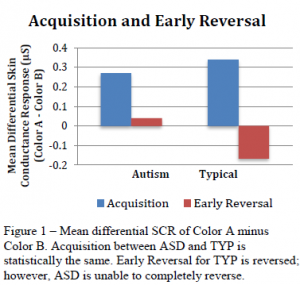Tiffani Newton and Dr. Mikle South, Department of Psychology
Background
The autism spectrum disorders (ASD) include a collection of severe neurodevelopmental symptoms related to social interaction and communication. In addition to these core symptoms, co-occurring anxiety is seen in up to 70% of diagnosed individuals (Reaven, 2010). Anxiety-inducing situations for ASD individuals include changes to the environment or daily routines. Difficulties responding to such changes may lead to debilitating and negative consequences for ASD children and their families. Understanding the mechanisms that lead to such difficulties may improve the specificity of treatment for these symptoms.
Reversal learning tasks used in both animal and human models have shown how the amygdala and orbitofrontal cortex work together to process sudden changes in the environment. The amygdala is a brain region thought to play multiple important roles in the development of autism, but research regarding the involvement of the amygdala in symptoms of anxiety is underdeveloped (Amaral et al., 2008). One critical role of the amygdala is to integrate information from nearby orbitofrontal cortex regarding the continued relevance of fear stimuli (Schiller et al., 2010). Schiller et al. adapted an animal study of fear reversal learning (learning to switch an old threat for a new one) for use in humans, similar to Pavlovian fear conditioning. Previous fear conditioning studies done in autism have included different paradigms with mixed results and large age ranges. To date, there have been no reversal studies done on autism. We adapted Schiller’s reversal learning to study older children and adolescents diagnosed with ASD in order to improve understanding of the connections made between the prefrontal cortex and the amygdala.
Procedure
During the task, participants viewed alternating computer presentations of two colored squares (yellow and blue). During the Acquisition stage, either a blue or a yellow square would appear on the monitor for 4 seconds, appearing in a pseudo-random order. One stimulus was assigned, in counterbalanced order across participants, as the threat conditioned stimulus (CS+) and the other as the safe stimulus (CS-). Participants were not aware of the assignment; however, one out of every three times the CS+ was shown, it was followed immediately by a surprising burst of air at the participant’s neck. After 24 trials the task was reversed so that the CS- stimulus now became the threat stimulus followed by the air puff on 33% of trials. We measured skin conductance response (SCR) and heart rate (HR) using the Biopac MP150 psychophysiology recording system. All procedures were approved by the IRB. We hypothesized that the autism group would show a delayed recovery and reversal learning.
Results
Participants (typical TYP n=30; ASD n=30) are matched for age (range 11-16) and IQ (at or above normal range). SCR measurements during Early and Late Acquisition phases were significantly above baseline levels and did not differ between groups, showing robust fear conditioning in both groups. During Early Reversal, however, the TYP group showed significantly stronger response to the new fearful stimulus (CS+) than to the previous fearful stimulus (CS-) seen in Acquisition. These results match Schiller’s findings seen in TYP adults.
However, the ASD group does not respond with a greater fear for CS+. Instead, it responds less to the old fearful stimulus (new CS-), but does not make the complete reversal to the new fearful stimulus (see Figure 1).

Conclusions
Results are found that TYP and ASD demonstrate equivalent levels of fear learning during Acquisition. This suggests that the amygdala is intact in exhibiting the emotion of fear. However, the ASD group is not able to make the change during the Early Reversal phase. This suggests that there is a possible disconnect between the amygdala and the prefrontal cortex in ASD in that the emotional responses found in the amygdala are unable to make the connection to the prefrontal cortex and back again, as necessary for reversal learning. Evidence supports the idea that ASD may be marked by poor integration of the amygdala-orbital frontal-striatal system, and is unable to fully control fear in affected children.
This finding is imperative and potentially groundbreaking in that it allows us to focus on that integration system in order to find the differences in autism. Future research will focus on fMRI studies to further observe regions of the brain used during a reversal task. The present SCR results suggest that difficulty in dealing with changes in ASD may occur at a fundamental, early processing level. We discuss the viability of using the air puff device as a safe but effective aversive unconditioned stimulus, as well as potential for future studies using the reversal learning paradigm.
This research is currently being prepared for submission into a peer-reviewed journal. It will be presented at the Snowbird Conference on October 21, 2011 as well as the BYU Mary Lou Fulton Mentor Research Conference in April, 2012.
The experiences that I have gained through ORCA have allowed me to excel in critical thinking and implementation, presentation, and many other skills. As I apply to graduate schools, I lean on the experiences and skills that I have developed while working with Dr. Mikle South. Dr. South has been and continues to be an outstanding mentor, allowing me to design, run, analyze, and write results for this project with his key assistance and guidance.
Thanks to participants and their families for their ongoing willingness to support this research. Thanks to Whitney Ernst, Paul Chamberlain, Sarah VanTassell, and Elaine Huntsman for their assistance in data collection and extraction.
